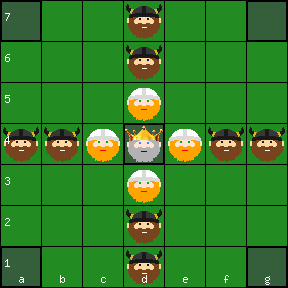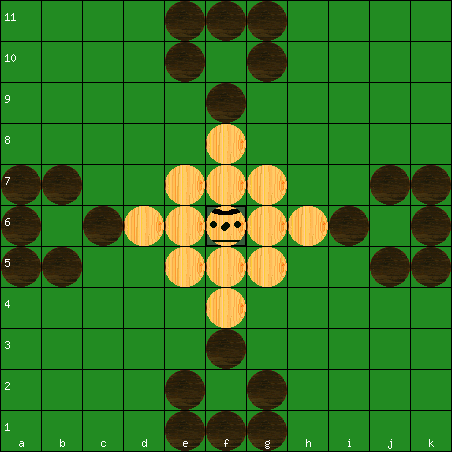Historical Hnefatafl
Historical Hnefatafl
We've now reached a point where a clear picture of the Historical Hnefatafl has emerged.
See
http://aagenielsen.dk/historical_hnefatafl_rules.php
See
http://aagenielsen.dk/historical_hnefatafl_rules.php
Re: Historical Hnefatafl
Our tournament tests showed that
- Brandubh (cross) is the only well balanced setup for brandubh.

- Saami Tablut, this setup was given directly by the Linné diary.

- Tawlbwrdd (Bell), only two setups are well balanced, and the Bell appears to be the more reasonable and probable of the two.

And they all appear to be the same sole game, the historical Iron Age Hnefatafl, only played on various board sizes.
It's already today on this site the exact same rule set for all three games, the proposed Historical Hnefatafl rules, differing solely in the board sizes, plus that Brandubh plays to corner and so adds four restricted corner squares.
The Saami rules we recognised by December 2013:
http://aagenielsen.dk/hnefataflforum/ph ... art=30#p13
and following forum notes.
As for Brandubh, after shortly testing various possibilities, the Saami rules were found to work best also for Brandubh:
http://aagenielsen.dk/hnefataflforum/ph ... &t=37#p505
And regarding Tawlbwrdd, recently I became aware of the ip Ifan diagram and realised that Tawlbwrdd has a throne just like the others, and so also the Tawlbwrdd rules became identical to Saami. Simultaneously, the ip Ifan diagram confirmed the Saami rules, by confirming that there are no base camps:
http://aagenielsen.dk/hnefataflforum/ph ... p=612#p612
One of these three games being the Saami Tablut, which we so carefully investigated December 2013, and which is solidly based on detailed historical description (the golden Linné diary). Because of the well documented Saami game, I believe this to be the historical rules of the Iron- and Viking Age game Hnefatafl. And also supported by the ip Ifan Tawlbwrdd diagram, the Ballinderry board, the Oslo board and the Trondheim board.
- Brandubh (cross) is the only well balanced setup for brandubh.

- Saami Tablut, this setup was given directly by the Linné diary.

- Tawlbwrdd (Bell), only two setups are well balanced, and the Bell appears to be the more reasonable and probable of the two.

And they all appear to be the same sole game, the historical Iron Age Hnefatafl, only played on various board sizes.
It's already today on this site the exact same rule set for all three games, the proposed Historical Hnefatafl rules, differing solely in the board sizes, plus that Brandubh plays to corner and so adds four restricted corner squares.
The Saami rules we recognised by December 2013:
http://aagenielsen.dk/hnefataflforum/ph ... art=30#p13
and following forum notes.
As for Brandubh, after shortly testing various possibilities, the Saami rules were found to work best also for Brandubh:
http://aagenielsen.dk/hnefataflforum/ph ... &t=37#p505
And regarding Tawlbwrdd, recently I became aware of the ip Ifan diagram and realised that Tawlbwrdd has a throne just like the others, and so also the Tawlbwrdd rules became identical to Saami. Simultaneously, the ip Ifan diagram confirmed the Saami rules, by confirming that there are no base camps:
http://aagenielsen.dk/hnefataflforum/ph ... p=612#p612
One of these three games being the Saami Tablut, which we so carefully investigated December 2013, and which is solidly based on detailed historical description (the golden Linné diary). Because of the well documented Saami game, I believe this to be the historical rules of the Iron- and Viking Age game Hnefatafl. And also supported by the ip Ifan Tawlbwrdd diagram, the Ballinderry board, the Oslo board and the Trondheim board.
Re: Historical Hnefatafl
Damian Walker did this excellent summary on the Historical Hnefatafl Rules process:
http://tafl.cyningstan.com/post/1529/hn ... ame-design
http://tafl.cyningstan.com/post/1529/hn ... ame-design
Re: Historical Hnefatafl
This is a great resource, it seems the only thing not 100% certain for now is the layout.
I've assumed in my games that the King could move one space from the citadel into a space surrounded by three enemies without being captured as it seems that no piece is captured in a passive way. I was wondering how others played that scenario.
Also I was wondering if you also use this rule as follows (or is it a mistranslation?):
10. If the king, being in his own square or castle, is encompassed on three sides by his enemies, one of them standing in each of three of the squares numbered 2, he may move away by the fourth.
If one of his own people happens to be in this fourth square, and one of his enemies in number 3 next to it, the soldier thus enclosed between his king and the enemy is killed.
I thought this may have been something observed by Linnaeus, maybe to prevent a sort of stalemate condition?
Cheers,
Kev.
I've assumed in my games that the King could move one space from the citadel into a space surrounded by three enemies without being captured as it seems that no piece is captured in a passive way. I was wondering how others played that scenario.
Also I was wondering if you also use this rule as follows (or is it a mistranslation?):
10. If the king, being in his own square or castle, is encompassed on three sides by his enemies, one of them standing in each of three of the squares numbered 2, he may move away by the fourth.
If one of his own people happens to be in this fourth square, and one of his enemies in number 3 next to it, the soldier thus enclosed between his king and the enemy is killed.
I thought this may have been something observed by Linnaeus, maybe to prevent a sort of stalemate condition?
Cheers,
Kev.
Re: Historical Hnefatafl
Love the article and the Historical Hnefatafl rule set. Nice having a historical and playable set of rules.
I think this instead refers to the 4 sided capture of the king when he is on the throne. In the Linnaeus diagram the squares marked 2 are the four squares adjacent to the throne so if the king was surrounded on three sides by his enemies he could move away by way of the fourth open square marked 2 as opposed to the captured against the king on his throne rule.10. If the king, being in his own square or castle, is encompassed on three sides by his enemies, one of them standing in each of three of the squares numbered 2, he may move away by the fourth.
Re: Historical Hnefatafl
Thanks for the reply Tuireann
Yes, that part seems clear, I was referring to the following section:
http://www.uusikaupunki.fi/~olsalmi/Tablut.html in the Tablut thread on this forum and another site too..
I had to include the previous paragraph so that the placement of the pieces was understood.
On Linnaeus' diagram, this suggests three enemies in square number 2 and an ally in the last one, when an enemy moves into square number 3 next to the ally, he is is killed between the citadel and the enemy.
so
_|_|E|_|_
_|E|K|E|_
_|_|A|_|_
_|_|_|E|_
becomes
_|_|E|_|_
_|E|K|E|_
_|_|_|_|_
_|_|E|_|_
I was just wondering if anyone else played it...
Cheers
Kev
Yes, that part seems clear, I was referring to the following section:
I've noticed it from this translationIf one of his own people happens to be in this fourth square, and one of his enemies in number 3 next to it, the soldier thus enclosed between his king and the enemy is killed.
http://www.uusikaupunki.fi/~olsalmi/Tablut.html in the Tablut thread on this forum and another site too..
I had to include the previous paragraph so that the placement of the pieces was understood.
On Linnaeus' diagram, this suggests three enemies in square number 2 and an ally in the last one, when an enemy moves into square number 3 next to the ally, he is is killed between the citadel and the enemy.
so
_|_|E|_|_
_|E|K|E|_
_|_|A|_|_
_|_|_|E|_
becomes
_|_|E|_|_
_|E|K|E|_
_|_|_|_|_
_|_|E|_|_
I was just wondering if anyone else played it...
Cheers
Kev
Re: Historical Hnefatafl
Oooooooooooh I thought you meant that as an alternate interpretation!  my bad.
my bad. 
I've never seen a variant rule set with it recently however the old Hnefatafl java applet had a version of this where you could set the 'Hostile' to 'King' And anyone, even an ally to the King, could be captured against the King while he was on the Throne. It was not in the situation as described though it was just any piece between the King on the Throne and 3. But as you have put it does seem to be what that indicates.
Edit:
The rules as such are attested here:
http://tafl.cyningstan.com/page/170/tablut
It would seem to be a particularly specific rule. I've not see the situation come up.
Another Edit:
'Reconstructing Hnefatafl' by Damian Walker shows these are rules that were translated in the original James Edward Smith translation of Linneaus' Latin text and offers some commentary on them regarding contradiction and redundancy with other rules.
I've never seen a variant rule set with it recently however the old Hnefatafl java applet had a version of this where you could set the 'Hostile' to 'King' And anyone, even an ally to the King, could be captured against the King while he was on the Throne. It was not in the situation as described though it was just any piece between the King on the Throne and 3. But as you have put it does seem to be what that indicates.
Edit:
The rules as such are attested here:
http://tafl.cyningstan.com/page/170/tablut
It would seem to be a particularly specific rule. I've not see the situation come up.
Another Edit:
'Reconstructing Hnefatafl' by Damian Walker shows these are rules that were translated in the original James Edward Smith translation of Linneaus' Latin text and offers some commentary on them regarding contradiction and redundancy with other rules.
Re: Historical Hnefatafl
Thanks again for replying, and taking the time to supply those references!
Yes I've had the situation come up a couple of times, and played it as described. I'm not sure what rules most people play so was interested to see.
That book looks like an interesting read so I'll give it a try!
Cheers
Kev
Yes I've had the situation come up a couple of times, and played it as described. I'm not sure what rules most people play so was interested to see.
That book looks like an interesting read so I'll give it a try!
Cheers
Kev
Re: Historical Hnefatafl
norsecode wrote:10. ...
If one of his own people happens to be in this fourth square, and one of his enemies in number 3 next to it, the soldier thus enclosed between his king and the enemy is killed.
We've not used the rule 10b on this site, because this rule detail seems to be not necessary, since the defender next to the king can be captured by two attackers the ordinary way.Tuireann wrote:The rules as such are attested here:
http://tafl.cyningstan.com/page/170/tablut
Re: Historical Hnefatafl
Thanks for the reply Hagbard. That's interesting that you have chosen to ignore it but I guess it really only speeds up the game a bit for the attackers anyway, so doesn't really detract from the fundamentals of the game.
Cheers
Kev.
Cheers
Kev.